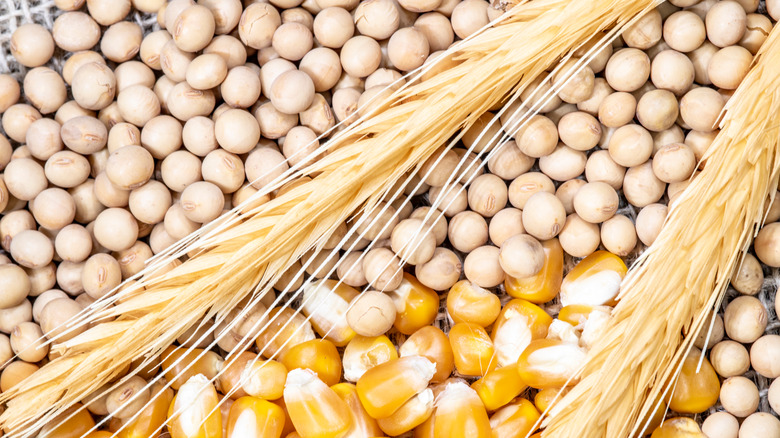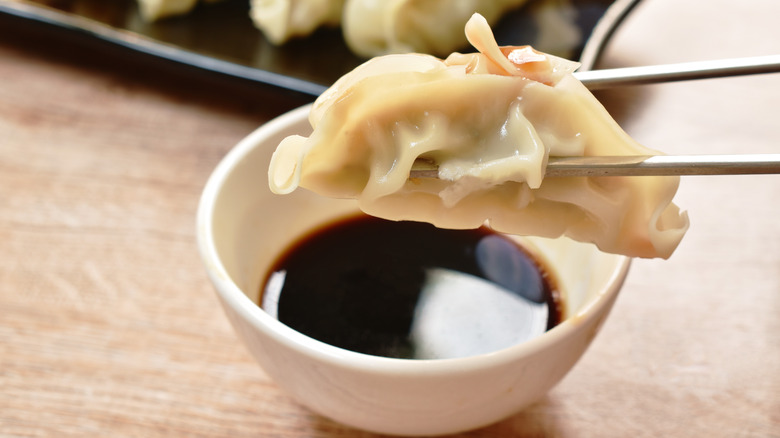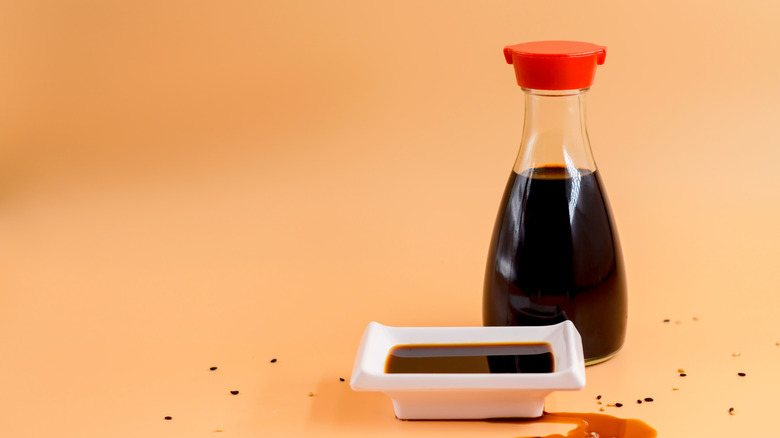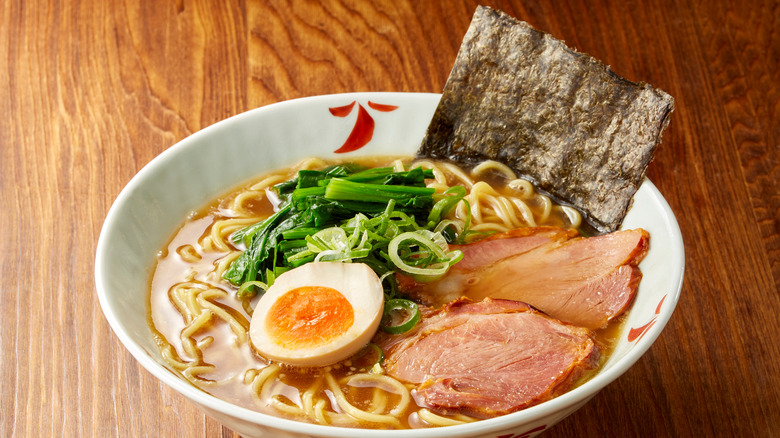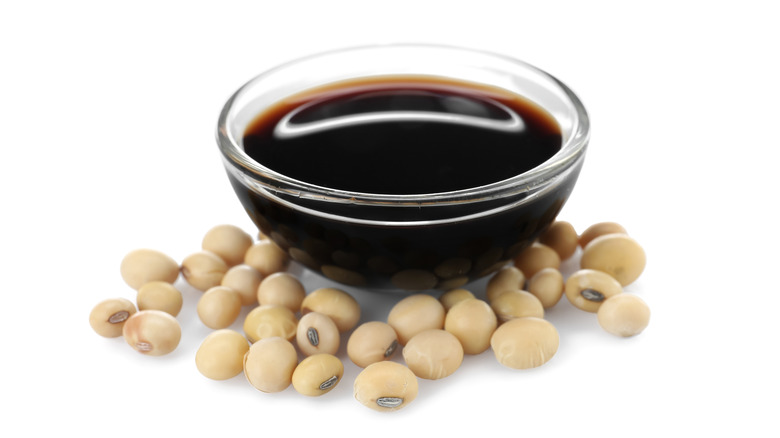What Is Shoyu And What Does It Taste Like?
Let's broaden your mind today by introducing you to the world of soy sauce. Not just one soy sauce, but the many popular, unique, and delightful flavors they have. You're probably wondering what this has to do with shoyu. So, let's take a dip into the flavor pool.
There are multiple different kinds of soy sauce, whether Chinese-style or Japanese-style. It was first invented about 2,000 years ago during the Western Han dynasty of ancient China, per The Eater. It was later spread throughout East and Southeast Asia, where it became a staple food ingredient and condiment.
Soy sauce is a thin and somewhat bitter liquid that has become a popular dipping sauce as well as an ingredient in stir-fries, rice dishes, and sushi. But the real information is that there are different styles of soy sauce, and one of them is shoyu. Let's break it down.
What is shoyu?
If you have read this far, let's hope you at least know soy sauce is a component! Shoyu is actually just the Japanese-style of making it, per The Eater. Unlike regular soy sauce, or Chinese-style, it is not made with 100% soy and no other ingredients added. There is a difference in what goes into making it, says My Recipes.
Shoyu is actually a 50/50 mix of soybeans and wheat. This mix brings a different flavor and level of color to a dish compared to regular soy sauce. It actually can be light, also known as usukuchi, or dark, known as koikuchi. It all depends on the fermentation process.
A very popular shoyu is called Kikkoman and the intricate fermentation process develops a unique flavor. A special Aspergillus mold is added to the soybeans and roasted wheat when being made, which produces a "koji" mash, says Kikkoman. After that, water and salt are added, and it is left alone for several months. Eventually, you end up with what you are dipping your dumplings in.
What does shoyu taste like?
Shoyu is a very complex sauce with a ton of flavor. For example, there are over 300 different flavor profiles, with some giving hints of vanilla, fruit, whiskey, and espresso, per Kikkoman. While it is hard to pinpoint an exact taste, there are so many it doesn't really matter!
Regular soy sauce is 100% soybeans and that's it, nothing else is added. As we said, shoyu has a bit more in it, which means the flavor is going to be a bit different. While the typical soy sauce you think of is usually saltier and stronger, shoyu tends to give a sweeter taste and a more subtle flavor, per The Eater.
The two popular kinds of shoyu are koikuchi and usukuchi, which you learned above as a light and dark version. Koikuchi is popular for its richness and is darker in color. It lends well to marinades and dips. Usukuchi is lighter and salty. When it's being made, a sweet rice wine is added, making it sweeter than its cousin, per My Recipes.
Other kinds of soy sauce
If you are just someone who absolutely loves soy sauce, maybe fill your cabinet up with all of these options so you have a plethora of options. It's clear most people know about regular soy sauce and now shoyu, koikuchi, and usukuchi. But there are even more kinds to include in your cooking repertoire.
Looking for a gluten-free option? Well, you may want to stock up on tamari soy sauce then. This option has little to no wheat, making a great option for those with a gluten allergy. It is thicker than the usual soy sauce and richer in flavor, more sweet than salty, per My Recipes.
If you want more of a subtle hint of flavor rather than overpowering the entire dish, give shiro a spin. It is a type of shoyu, but a lighter variety. It will add shoyu flavor to whatever you are making, but won't turn it into a darker colored dish, meaning your veggies will still look pretty. This sweet option works great for steaming vegetables or in soups.
How to cook with shoyu
Much like your typical soy sauce, shoyu is great as a dipping sauce. Whether it be meats, steamed vegetables, sushi, or something else, there are plenty of options to dip. However, recipes like ramen or incredibly popular shoyu chicken are all about incorporating the soy sauce into the meal.
For example, shoyu is a main ingredient in ramen. Bon Appetit says to add it to the tare which is then added to the dashi, a stock in Japanese cuisine. The dashi is left to sit at room temperature for 8 to 12 hours. After that, you'll add the shoyu and mirin, which is the tare. This will become the yummy ramen broth that goes with pork, a boiled egg, noodles garnish.
Another well-known shoyu dish is shoyu chicken. If you simply google "shoyu recipes" you'll be flooded with a million and one to choose from. All it really is, though, is a marinade that you let your chicken soak in for about 8 hours. After that, fire up the pan, grill, or even air fryer and get to cooking. Things like brown sugar, water, garlic, ginger, pepper, red pepper flakes, onion, and oregano are added along with shoyu, per All Recipes.
Is it shoyu for you?
While shoyu or any soy sauce for that matter seems like a simple, light dipping sauce, it is not entirely healthy. For those who are allergic to gluten, wheat, or soy, soy sauce should be kept away from you at all times, says Health. It may not seem like much because of its low calories, but there are things to watch out for.
In one tablespoon of traditional fermented soy sauce you will find 8 calories, 1 gram of carbohydrates, 0 grams of fat, 1 gram of protein and a whopping 902 milligrams of sodium, per Healthline. In a day, one person should only consume about 1,5000 milligrams, meaning soy sauce isn't great for those trying to watch their sodium intake.
However, it isn't all bad news for this section! Due to the fermented process, there is research that shows it may help by adding beneficial bacteria to a person's digestive tract. It has also been linked to helping people with allergies — who knew? Overall, even the smallest bit of any kind of soy sauce will add a ton of salt and sodium to your diet, so maybe don't make it an everyday thing.

